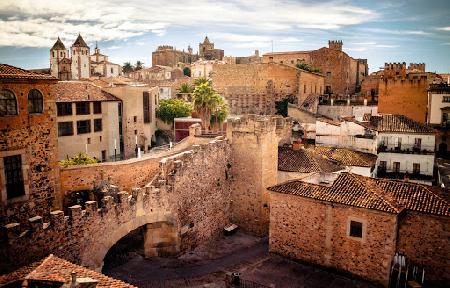
Cáceres is a city in western Spain, capital of the province of the same name. It is located in the central area of the ancient Roman province of Lusitania, in the autonomous community of Extremadura. With 94,179 inhabitants (INE 2010), it is the largest and most populous city in the province, accumulating 22.69% of its total population. It is also the largest municipality in Spain with an area of 1,750.33 km².
The «Monumental City of Cáceres» was declared by the Council of Europe as the Third Monumental Ensemble of Europe in 1968 (after Prague and Tallinn) and a UNESCO World Heritage Site in 1986. Cáceres also has other awards: Pomme d´Or for Tourism Merit, awarded by the International Federation of Tourism Journalists and Writers in 1996; Les Etoiles d´Or du Jumelage, awarded by the European Commission in 1999; the Archival Prize awarded by the Association for the Recovery of Historic Centers in 2004 and the 2008 Citizens Prize awarded by the Association of Digital Radio and Television Entities, with the collaboration of the Citizen Audiovisual Council for the support that citizens are providing to the Cáceres 2016 cultural candidacy.
Cáceres is also a member of the Sefarad Road Networks, of the Vía de la Plata, being chosen by the Autonomous Community as Cultural Capital of Extremadura Enclave 92, and together with the solidarity effort of the administrations, private companies, Official entities and private citizens, aspired between 2003 and 2010 to be the European Capital of Culture in 2016. It currently has 94,179 inhabitants (INE, 2010). Among the most famous festivals we mention, Las Candelas and San Blas, from February 1 to 3. They are two of the most popular festivals in the city. During the morning of February 2, the Virgen de las Candelas leaves in procession from the hermitage of the same name, located in the heart of the Monumental City.
The streets are decked out to receive the Virgin during her tour. The festival of San Blas is held in her hermitage, the same day of the Candelas, that is, the eve of the saint. The surroundings of the hermitage are filled with young people in the field dress and the beautiful scarf of watermelon or a thousand colors. During the afternoon of San Blas you can hear typical Extremaduran music. The city currently has more than 3,500 hotel beds and, with 660,668 visitors registered by municipal tourist centers during 2009, it becomes the first tourist center in the region in number of visitors.
